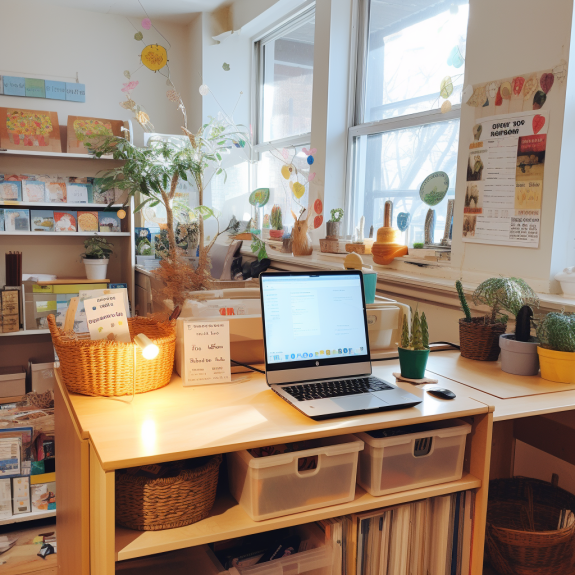The shift to virtual learning has brought about new challenges and opportunities, even for our youngest learners in preschool. Creating a stimulating online environment for virtual preschool classrooms requires thoughtful planning and consideration of the unique needs of preschoolers. In this article, we explore tips and strategies to design a virtual preschool classroom that engages young minds, fosters social interaction, and provides a supportive space for early learning.
1. Interactive Learning Platforms:
Choose interactive learning platforms that offer a variety of activities such as educational games, interactive stories, and virtual art projects. Platforms designed for preschoolers should be user-friendly, with large icons and simple navigation to ensure easy engagement.
2. Virtual Circle Time:
Replicate the traditional circle time virtually by gathering students for interactive sessions. Include activities like singing songs, sharing stories, and discussing daily themes. This fosters a sense of routine and community within the virtual preschool environment.
3. Creative Use of Visuals:
Utilize vibrant and engaging visuals to capture the attention of preschoolers. Incorporate colorful images, animated characters, and visually stimulating materials to make the online environment visually appealing and conducive to learning.
4. Themed Learning Units:
Organize learning units around exciting themes that capture preschoolers’ interests. Whether it’s exploring animals, outer space, or seasons, themed units provide a framework for varied and comprehensive learning experiences.
5. Hands-On Activities:
Integrate hands-on activities that children can do at home with readily available materials. These activities not only enhance learning but also provide a tactile and sensory component, crucial for the development of young minds.
6. Small Group Activities:
Facilitate small group activities to encourage social interaction. Virtual breakout sessions can be used for collaborative projects, fostering a sense of connection and teamwork among preschoolers.
7. Virtual Show-and-Tell:
Incorporate virtual show-and-tell sessions where preschoolers can share items from their homes, fostering language development and confidence in expressing themselves.
8. Parental Involvement:
Encourage parental involvement by providing resources and suggestions for extending learning beyond the virtual classroom. This collaborative approach strengthens the connection between home and school.
9. Flexible Scheduling:
Recognize the need for flexibility in scheduling virtual preschool sessions. Shorter, more frequent sessions may be more effective in maintaining engagement compared to longer, less frequent ones.
10. Virtual Field Trips:
Take virtual field trips to explore different places or learn about specific topics. Utilize online resources, videos, and interactive platforms to create immersive virtual experiences.
11. Storytelling and Music Sessions:
Incorporate regular storytelling and music sessions into the virtual classroom. Engage preschoolers with captivating stories and interactive music activities to enhance language skills and creativity.
12. Consistent Communication:
Establish consistent communication channels with parents to share updates, learning objectives, and resources. Open and transparent communication helps create a supportive virtual learning community.
13. Virtual Praise and Recognition:
Implement virtual praise and recognition systems to celebrate achievements and positive behavior. This can include virtual stickers, certificates, or simple acknowledgments during online sessions.
14. Individualized Attention:
Strive to provide individualized attention during virtual sessions. Addressing each child by name, personalizing feedback, and recognizing their contributions fosters a sense of value and belonging.
15. Emphasis on Social-Emotional Learning:
Integrate activities that focus on social-emotional learning. Use virtual platforms to facilitate discussions on feelings, empathy, and cooperation, laying the foundation for emotional intelligence.
16. Professional Development for Educators:
Offer ongoing professional development opportunities for educators to enhance their skills in managing virtual preschool classrooms effectively. This includes staying updated on educational technology and online teaching strategies.
17. Regular Assessments and Feedback:
Conduct regular assessments of preschoolers’ progress and provide constructive feedback to parents. This collaborative approach ensures that both educators and parents are actively involved in monitoring the child’s development.
18. Celebrate Milestones:
Celebrate developmental milestones virtually, such as birthdays or achievements. Virtual celebrations maintain a sense of normalcy and contribute to a positive and supportive online learning environment.
By implementing these tips, educators and parents can work together to create a virtual preschool classroom that not only meets educational objectives but also nurtures the holistic development of young children. In navigating the challenges of virtual learning, a creative and collaborative approach ensures that the virtual preschool experience is both enriching and enjoyable for our little learners.

